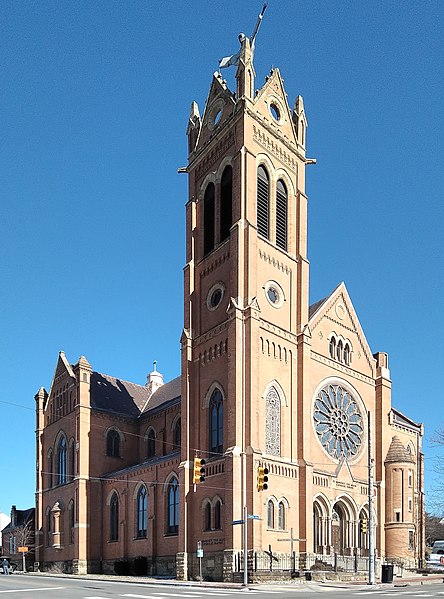
With the Lower Hill demolished and replaced with a modernist wasteland, this church became the gateway to the Hill District. There may be no more effective religious statue in all of Pittsburgh than the statue of St. Benedict the Moor (by Frederick Charles Shrady) on top of the tower, his arms spread wide to welcome us to his neighborhood. The Gothic church, built in 1894, was designed by Moeser & Bippus. They had their offices downtown on Liberty Avenue,(1) so there must be other buildings by them in the area, but old Pa Pitt does not know of any; he would be delighted if someone could name a few, or even one. It originally belonged to Holy Trinity, a German Catholic parish.


And now let us say something for a moment about the ethnic diversity of the Hill a hundred years ago. If you stayed within six blocks of this German church, you could have visited two African Methodist Episcopal churches and one “colored” Presbyterian church, an Irish Catholic church, a Greek Catholic (that is, Byzantine Catholic) church, a Black Baptist church, and every kind of synagogue:
Congregation Machsike Hadas
Beth Jacob Congregation
B’nai Israel Congregation
Gates of Wisdom Synagogue
Congregation Tent of Jacob
Tiphereth Israel Congregation
Paolo Zaoec Synagogue (Austro-Hungarian)
Congregation Shaare Tefilla
Congregation Kanascis Israel
And doubtless some others; we have just been glancing at the 1923 maps at the Pittsburgh Historic Maps site and have not made any scientific survey. This was not the whole Hill, of course; we have kept within a short walk of today’s St. Benedict the Moor. People of all sorts lived side by side in a crowded but lively neighborhood. Over at Pittsburgh Cemeteries, Father Pitt has noticed the ethnic diversity of the Hill reflected in the Minersville Cemetery on the Upper Hill, a German Lutheran cemetery that nevertheless found space for people whose tombstones are written in Slovak, Greek, and Arabic.
That the Hill became an almost exclusively Black neighborhood was the result of deliberate public policy. A neighborhood where races mixed was defined as a slum, and slums had to be cleared. Of the streets we were just walking in our imagination, half were simply demolished. The rest was marked out as a Black neighborhood; other residents had every incentive to move to areas from which Blacks were excluded by invisible red lines, though many businesses continued to be owned by former residents who had moved away, until the 1968 riots discouraged them.
The human spirit triumphs over inhumanity, however, and today’s Hill is a neighborly neighborhood. It is not prosperous; it has lost far too many buildings and gained too many vacant lots. But it is a place where people practice the neighborly virtues, and we hope that from that precious resource will come a revival of the lesser assets as well.
Footnotes
- According to this Directory of Pittsburgh and Allegheny. (↩)

3 responses to “St. Benedict the Moor Church, Hill”
[…] Story continues […]
It looks as though Moeser & Bippus were more active in Ontario than in PIttsburgh. Here’s the encyclopedia entry:
Moeser, Henry A.
MOESER, Henry A. (1821-1908) was active in Pittsburgh, Penn., at first under his own name, and later in the partnership of Moeser & Wilson (1891-92), and Moeser & Bippus (1895-96). In 1891 he was commissioned to design major additions to the Mount Carmel Hospice, Stanley Street, in Niagara Falls, Ont., the first portions of which had been completed by George Metzger of Buffalo, N.Y. in 1882. Moeser was responsible for the distinctive Romanesque Revival dormitory wing and the adjacent chapel, with its arcaded walkways and circular corner towers. The complex was constructed for the Carmelites as a hospitality centre for pilgrims visiting the nearby Shrine of Our Lady of Peace. Moeser later carried out a similar commission at Fairview, Perth Co., Ont. for the Carmelite monastery there.
Moeser was born in Darmstadt, Germany on 2 May 1821 and was educated and trained there. He emigrated to America in 1850, and spent his entire professional career in Pittsburgh. He died there on 3 January 1908 (obituary Pittsburgh Press, 4 Jan. 1908, 3; obit and biography Pittsburgh Daily Post, 5 Jan. 1908, 9)
NIAGARA FALLS, ONT., major additions to Mount Carmel Hospice, Stanley Street, 1891-99 (Catholic Record [London], 28 Nov. 1891, 5, descrip.; Catholic Register [Toronto], 6 July 1899, 6, descrip.)
FAIRVIEW, ONT. [near Stratford, Ont.], major addition to the monastery of the Fathers of the Order of Our Lady of Mount Carmel, 1899 (C.R., x, 5 July 1899, 2)
Thank you very much for this. It is a curious enigma. Moeser “spent his entire professional career in Pittsburgh,” but the first thing that comes up in a Google search is his entry in the “Dictionary of Architects in Canada,” which is for two relatively minor commissions when he was already quite old: he was seventy when the earlier of the two was built. (He was 73 when St. Benedict the Moor was built.) Old Pa Pitt suspects that there are several churches or other ecclesiastical buildings by Moeser & Bippus sitting around very nearby, but not identified: after all, he had to be doing something in the four decades between the time he arrived and the time he got his first commission in Canada. This is probably a project for research in old architectural magazines from the nineteenth century, and the proper way to get research like that done is to find a graduate student who will do it for the educational value and not think of asking to be paid.